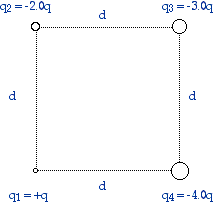
Problem 1
Two point charges of equal magnitude are 8.0 cm apart. At the
midpoint of the line connecting them, their combined electric field
has a magnitude of 25 N/C. Find the magnitude of the charges.
Ans. 2.2 x 10-12 C
Problem 2
Find the direction and magnitude of the net electrostatic force
exerted on the point charge q3 in the diagram. Let q =
+1.8 microcoulumbs and d = 22 cm.

Ans. 7.2 N, q
= 66o
Problem 3
A parallel-plate capacitor has plates with an area of 0.012
m2 and a separation of 0.88 mm. The space between the
plates is filled with a dielectric whose dielectric constant is 2.0.
What is the potential difference between the plates when the charge
on the capacitor plates is 4.7 microcoulumbs?
Ans. 19,000 V
Problem 4
a) Find the electric potential at point P in the diagram. b) Suppose
the three charges shown in the diagram are held in place. A fourth
charge, with a charge of 6.11 microcoulumbs and a mass of 4.71 g, is
released from rest at point P. What is the speed of the fourth charge
when it has moved infinitely far away from the other three
charges?
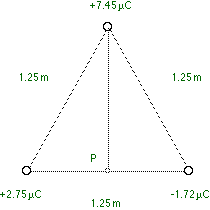
Ans. 76700 V, 14.1 m/s
Problem 5
Find the current flowing through each of the resistors in the circuit
below using the rules for series and parallel resistors.
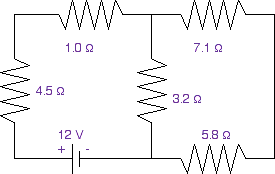
Ans. 1.5A through 4.53W
and 1.0W,
1.2A through 3.2W,
.30A through 7.1W
and 5.8W
Problem 6
Find the current in each resistor in the circuit below.
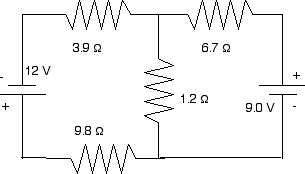
Ans. .91 A through 3.9W
and 9.8W,
.37A through 1.2W,
.1.3A through 6.7W
Problem 7
Two capacitors, one 7.5 microfarads the other 15 microfarads, are
connected in series across a 12-V battery. a) Find the equivalent
capacitance of the two capacitors. b) Which capacitor stores more
charge? Explain. c) Find the charge stored on each capacitor.
Ans. 5mF,
same since hooked up in series, 60mC
Problem 8
A beam of protons with various speeds is directed in the positive x
direction. The beam enters a region with a uniform magnetic field of
magnitude 0.52T pointing in the negative z direction as indicated in
the diagram. It is desired to use a uniform electric field (in
addition to the magnetic field) to select from this beam only those
protons with a speed of 1.42 x 105 m/s - that is, only
these protons should be undeflected by the two fields. a) Determine
the magnitude and direction of the electric field that yields the
desired result. b) Suppose the electric field is to be produced by a
parallel-plate capacitor with a plate separation of 2.5 cm. What
potential difference is required between the plates? c) Which plate
in the diagram (top or bottom) should be positively charged?
Explain
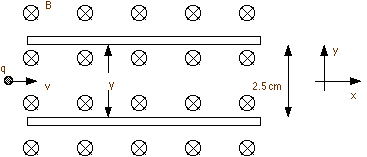
Ans. 74000 N/C, 1800 V, Top
Problem 9
When at rest a proton experiences a net electromagnetic force of
magnitude 8.0 x 10-13 N pointing in the positive x
direction. When the proton moves with a speed of 1.5 x 106
m/s in the positive y direction the net electromagnetic force on it
decreases in magnitude to 7.5 x 10-13 N, still pointing in
the positive x direction. Find the magnitude and direction of a) the
electric field and b) the magnetic field.
Ans. 5.0 x 106 N/C, .21 T
Problem 10
A wire with a current I is placed under a clear sheet of plastic, as
shown below. Three loops of wire, A, B, and C, are placed on the
sheet of plastic at the indicated locations. If the curent in the
wire is increased, indicate whether the induced emf in each of the
loops is clockwise, counterclockwise, or zero. Explain your answer
for each loop.
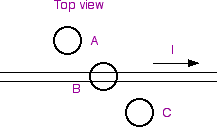
Ans. A - clockwise, B - zero, C -
counterclockwise
Problem 11
Consider a rectangular loop of wire 6.0 cm by 8.0 cm in a uniform
magnetic field of magnitude 1.3 T. The loop is rotated from a
position of zero magnetic flux to a position of maximum flux in 21
ms. What is the average induced emf in the loop?
Ans. -.30V
Problem 12
You are given a sealed box with two electrical terminals. The box
contains a 5.00 ohm resistor in series with either an inductor or a
capacitor. When you attach an ac generator with an rms voltage of
0.750 V to the terminals of the box, you find that the current
increases with increasing frequency. a) Does the box contain an
inductor or a capacitor? Explain b) When the frequency of the
generator is 25.0 kHz, the rms current is 87.2 mA. What is the
capacitance or inductance of the unknown component in the box?
Ans. capacitor, .910mF
Problem 13
Albert is nearsighted, and without his eyeglasses he can focus only
on objects less than 3.0 m away. a) Are Albert's eyeglasses concave
or convex? Explain. b) To correct Albert's nearsightedness, his
eyeglasses must produce a vertual, upright image at a distance of 3.0
m when viewing an infinitely distant object. What is the focal length
of Albert's eyeglasses?
Ans. concave, -3.0 m
Problem 14
A thin layer of magnesium fluoride (n = 1.38) is used to coat a
flint-glass lens (n = 1.61). a) What thickness should the magnesium
fluoride film have if the reflection of 595 nm light is to be
suppressed? Assume that the light is incident at right angles to the
film. b) If it is desired to suppress the relection of light with a
higher frequency, should the coating of magnesium fluoride be made
thinner or thicker? Explain.
Ans. 108 nm, thinner
Problem 15
A glass paperweight with an index of refraction n rest on a desk, as
shown below. An incident ray of light enters the horizontal top
surface of the paperweight at an angle of q
= 77o to the vertical. a) Find the minimum value of n for
which there is total internal reflection on the vertical surface. b)
If q
is decreased, is the minimum value of n increased or decreased?

Ans. 1.40, decreased